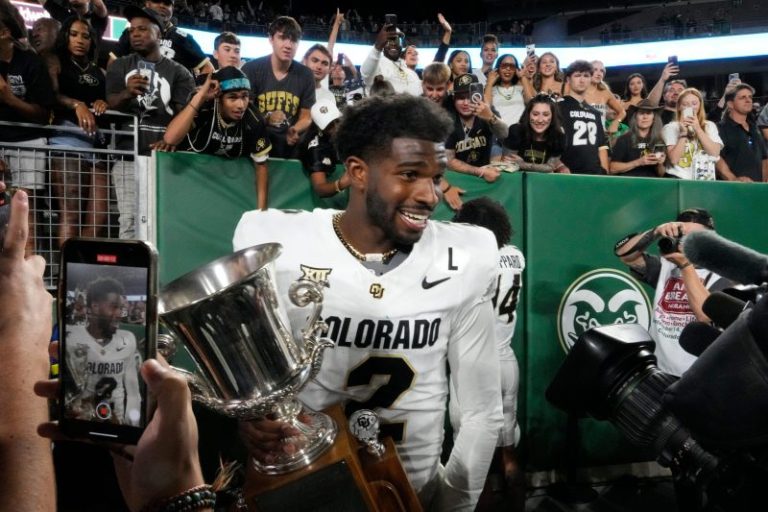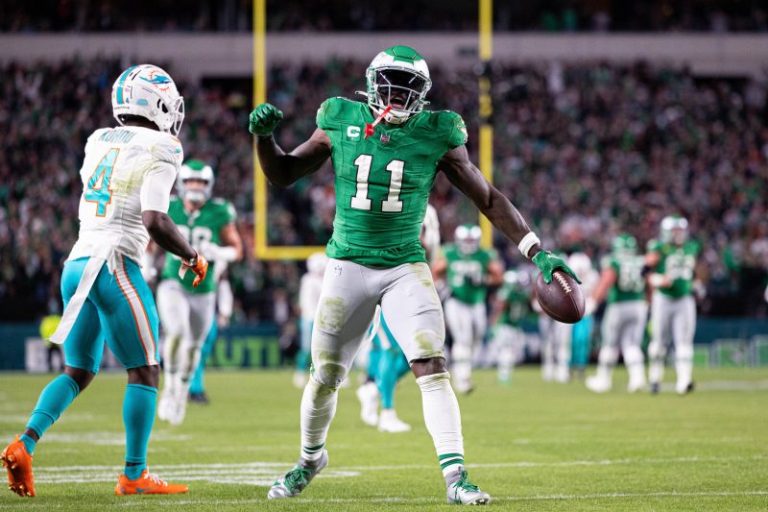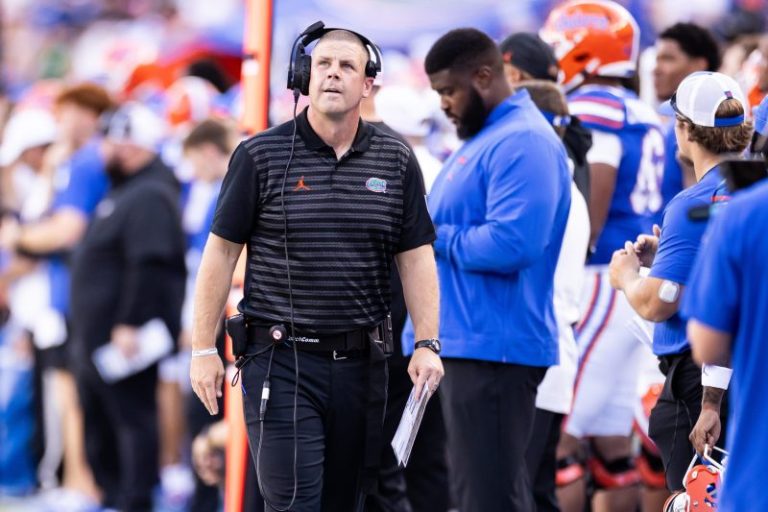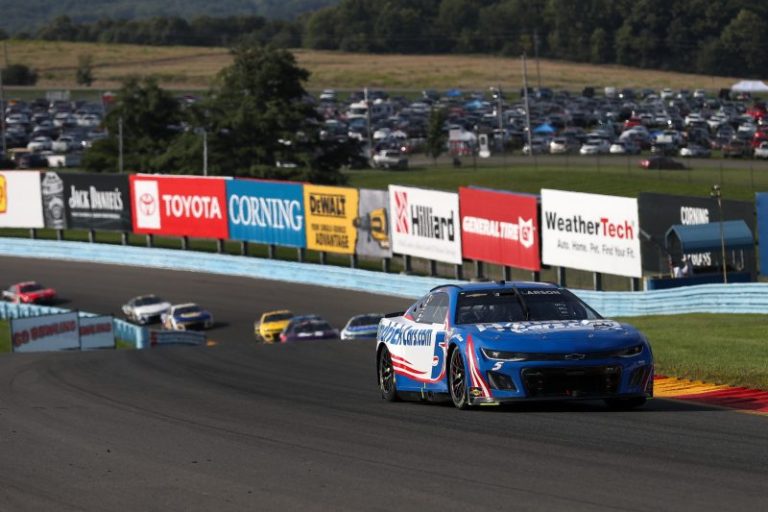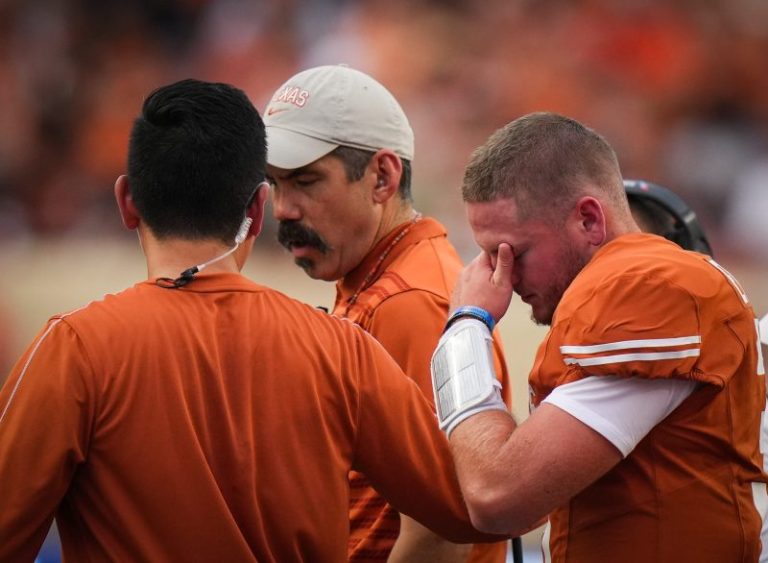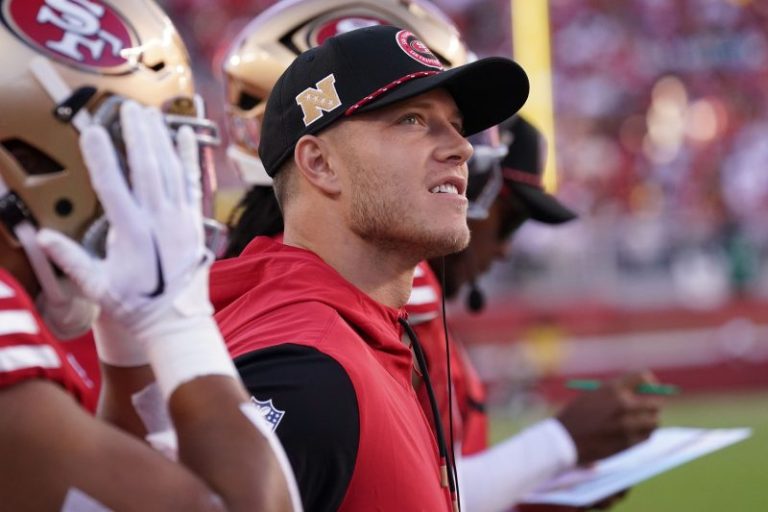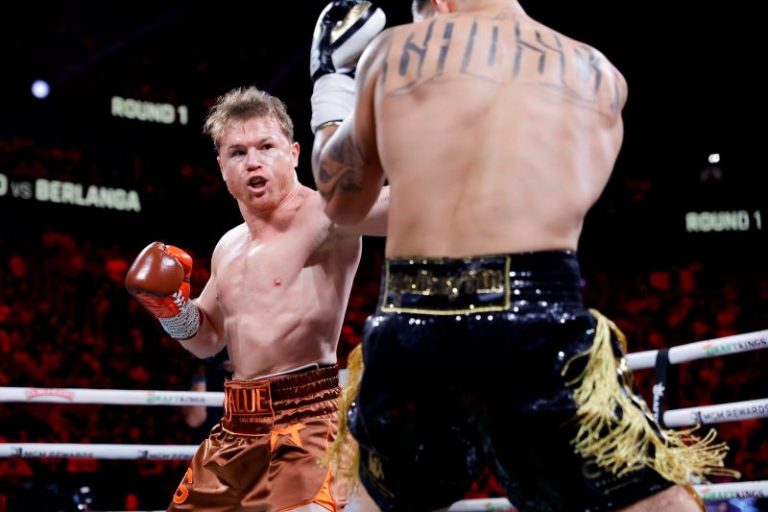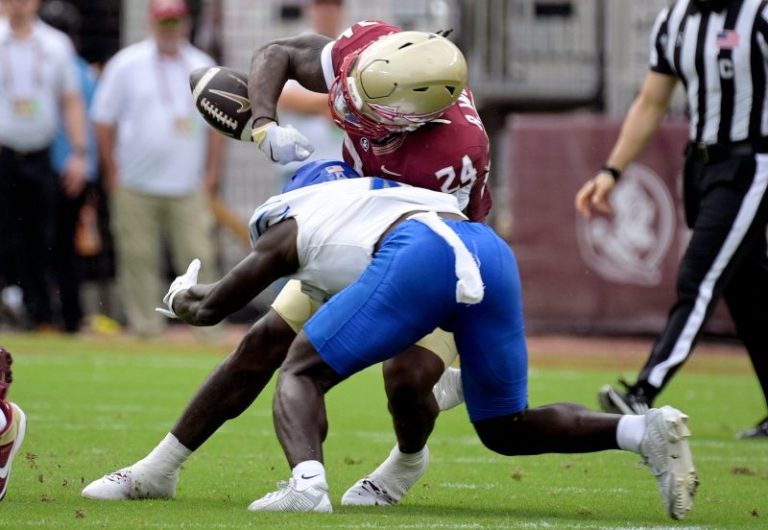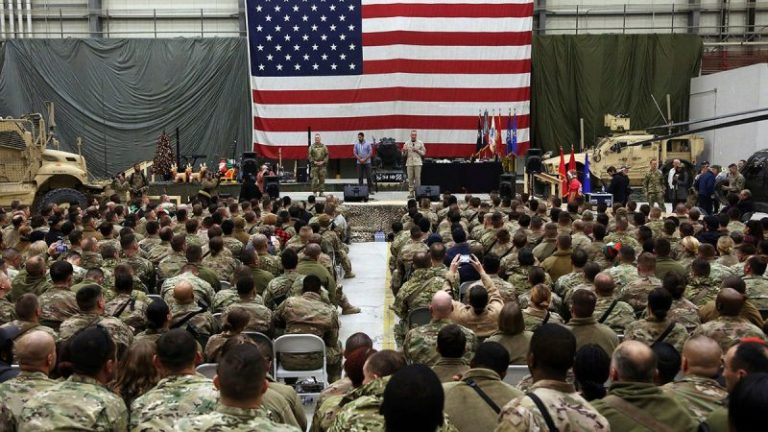Canelo Alvarez did not get the knockout he promised.
But he landed brutal punches (and took a few too) in an impressive victory over Edgar Berlanga by unanimous decision in the 12-round super middleweight fight.
The fighters had to be separated on multiple occasions and talked trash throughout the fight. Berlanga was warned for head butting at one point and Alvarez seemed to take exception to that and other Berlanga tactics. ‘I get a little angry,” Alvarez said. ‘A Mexican man.” The crowd roared with laughter.
The judges scored it 117-110, 118-109, 118-109.
“I’m the best fighter in the world,’’ Alvarez said, drawing cheers from the sellout crowd at T-Mobile Arena in Las Vegas.
Alvarez knocked down Berlanga with a left hook in the third round while defending his super middleweight title.
But Berlanga quickly got back on his feet and survived the onslaught in a 12-round bout.
Alvarez has now gone six fights without a knockout. The last one came in 2021 against Caleb Plant, who Alvarez stopped by TKO in the 11th round.
Saturday’s fight was billed as the latest chapter in the boxing rivalry between Mexico and Puerto Rico with Alvarez matched up against Berlanga, a native New Yorker whose parents are from Puerto Rico.
‘I could’ve did a lot more. But I was in there with a legend, man,’ Berlanga said.
Alvarez, 34, improved to 62-2-2. Berlanga, 27, fell to 22-1.
Canelo Alvarez vs. Edgar Berlanga, super middleweight, scheduled for 12 rounds
Round 1: Berlanga noticeably bigger than Canelo as they slowly circle at the center of the ring. Berlanga is 6-1 and Canelo is 5-7 ½. Chants are up. “Canelo, Canelo!’’ Canelo stalking and throwing jabs. Berlanga throws a jab but Canelo pushes forward. Berlanga talking trash. Canelo still pressing, but Berlanga answers with a couple of jabs. Canelo does enough to take the round. Canelo 10, Berlanga 9.
Round 2: Before Berlanga comes out for the round, his trainer: “We’ve got to go to hell to get this.’’ Canelo surely intends to make it at least that hard. Still a lot of hesitation here. Canelo lands a big body shot. Berlanga fires back with two nice punches. Berlanga wraps up Canelo and the crowd boos. Canelo lands a big left. Berlanga answers with a left and later scores with a body shot. Bergana starting to assert himself. Canelo 19, Berlanga 19.
Round 3: An exchange of solid lefts and more chants. “Mexico, Mexico!’’ A left drops Berlanga with a left hook! He’s up quickly, but what a shot. Canelo looking to end it, has Berlanga in the corner. Canelo firing and Berlanga responding with a missed haymaker. Berlanga appears to have evaded danger. For the moment. Canelo 29, Berlanga 27.
Round 4: Canelo eats a punch. Keeps moving forward. Hears the chants of “Canelo!’’ Clearly trying to delight the crowd. Berlanga firing back but Canelo appears to be setting himself up for something big. Digs a left into Berlanga’s gut. Berlanga not capitalizing on his size and reach advantage to this point. Canelo’s speed is still world class even at 34. Canelo 39, Berlanga 36.
Round 5: Canelo comes out with instructions and keeps jabbing. Berlanga must have gotten the same orders. He’s flicking jabs. Fighters get tangled up and it’s rough. They’re talking trash and the referee hits the deck as he tries to separate the fighters. Canelo fuming. He looks far more emotional than Berlanga. Canelo lands a hard uppercut. Berlanga shakes his head. Berlanga lands a hard right, but it hardly slows Canelo. Canelo 49, Berlanga 45.
Round 6: Berlanga still fighting on the defensive. Canelo slashes him with punches. Berlanga throws the jab with success. But still on the ropes, although he scores with a big right. Eats a right from Canelo. It’s getting more competitive again. And more chants. “Canelo! Canelo!”’ Canelo backs up Berlanga into the corner again. Canelo 59, Berlanga 54.
Round 7: Canelo comes out the aggressor again. Berlanga seems content to counter, but he’s yet to display the knockout power. Is he waiting for the late rounds to turn up the heat? Berlanga in a low crouch as if looking for an opening. Berlanga on the canvas, but it’s ruled a trip. Canelo 69, Berlanga 63.
Round 8: Berlanga pawing with the jabs. Then throws a hard right. Canelo with a sweeping left followed by a right. Some big exchanges here. Canelo caught Berlanga with a right on what appeared to be the break. Berlanga warned for a headbutt. Canelo giving, but getting a little too. Canelo dictating the action. Berlanga talking, maybe when he should be punching. Canelo 79, Berlanga 72.
Round 9: Canelo lands a massive right, but Berlanga responds. No one’s bleeding, but clear bad blood. The referees separates the boxers again. Canelo’s moving forward, and Berlanga’s standing his ground. Canelo 89, Berlanga 81.
Round 10: Berlanga running out of time here, as he continues to fight backing up. Berlanga shows sign of moving forward, but Canelo pushes back as he swings away. Sweat flies from Berlanga’s head as Canelo lands two solid punches. Trash talk resumes. Canelo tattoos Berlanga’s face with his right hand. More trash talk as the round ends. Canelo 98, Berlanga 91.
Round 11: Canelo charging forward. Emptying the tank as he throws punches. Berlanga appears to have hurt his right hand. Shook it as if in discomfort. Berlanga has holstered the right and now relying on the left. The fighters have to be separated as the round ends, trash talk flying again. Canelo 108, Berlanga 100.
Round 12: Berlanga waving his arms and the crowd boos. Canelo does the same and they cheer wildly. Canelo still shows head-snapping power with his punches. Berlanga’s head doing the snapping. More tangling and wrestling between the fighters. One thing for sure: Berlanga can take a punch. Trading huge punches. Bell rings, and the fighters hug. The trash talk ends. Canelo 118, Berlanga 109.
Who did Alvarez lose to?
In 2022, he lost to Dmitrii Bivol by unanimous decision in a 12-round light heavyweight bout.
In 2013, he lost to Floyd Mayweather by majority decision in a super welterweight bout.
Canelo Alvarez net worth
At least $275 million, according to Forbes.
Alvarez faces criticism for opponent selection
No David Benavidez. No Terence Crawford. No marquee opponent.
As Canelo Alvarez heads into the ring to face Edgar Berlanga, his reputation for supposedly ducking big fights persists. His Excellency Turki Alalshikh, the face of Saudi Arabian boxing promotion, addressed the issue after Alvarez said he respects Alalshikh but doesn’t like the way he does business.
“I only target big fights at fair prices, so of course anyone who likes easy fights won’t like that,” Alalshikh wrote in August on X, formerly Twitter. “And I know how he feels after losing to (Dmitrii Bivol in 2022), so he’s been looking for easier fights ever since. Also, I’m not the one who’s afraid of fighting Benavidez or Crawford.”
Erislandy Lara def. Danny Garcia by TKO
The crowd showered the two fighters with boos throughout the fight that ended with Lara’s ninth-round TKO.
They served up some extra boos after the fight both for the winner and the loser.
Lara, a 41-year-old Cuban, threw only 63 punches. One of those was a left hand that left Garcia on a knee at the end of the ninth round.
As he sat on the stool, his father told the referee to end the fight.
The moment was enough for Lara to retain his WBA middleweight title but not satisfy the crowd, which booed Garcia during an in-ring interview.
He landed only 33 punches during his first fight in two years.
“I’m sorry to everybody,’’ said Garcia, 36. “You know, I tried.’’
Lara improved to 31-3-3 and Garcia fell to 37-4.
Erislandy Lara vs. Danny Garcia, middleweight, scheduled for 12 rounds
Round 1: Lara leads with the jabs, but he’ll be looking to unleash KO power. Not much action, but Lara’s registering punches. Lara makes good use of the right hand in deflecting punches. But it’s of no use stopping whistles from the restless crowd. Lara 10, Garcia 9.
Round 2: Lara lands a head-snapping left, but that won’t be enough to satisfy the crowd. Garcia doing his best impression of a mannequin with boxing gloves. Lara lands some shots toward the end of the round, picking up points. Lara 20, Garcia 18.
Round 3: Garcia throws a punch. There is no standing ovation. In fact, eventually there are more boos. Lara strikes with the jabs. Lara 30, Garcia 27.
Round 4: More boos as Lara uses his defense and jab to tediously win rounds. Garcia looks hesitant to put himself in danger’s way. Garcia lands a body shot. Might be one to savor. Crowd boos as the round ends. Lara 40, Garcia 36.
Round 5: Garcia shows more aggression. But it looks like he’s chasing a ghost. Lara is that elusive. Lara 50, Garcia 45.
Round 6: Lara drills Garcia with a sharp jab. It’s a reminder of the danger Lara poses. And Lara keeps slipping, dodging and sidestepping punches. Lara 60, Garcia 54.
Round 7: Lara now stalking, but not pleasing the crowd. Still very little action here. Now might be a good time for a nap. More whistles and boos. Lara 70, Garcia 63.
Round 8: Garcia scores with a right, and Lara quickly responds with a shot of his own. Garcia throws a couple of rights. Lands one. Then a couple more. Garcia far more active, but Lara lands a shot on the chin. Lara 79, Gracia 73.
Round 9: Lara connects on a couple of head shots. Seems intent on regaining control after that last round. A chorus of boos turns into a symphony of boos. The fighters are not stirred into action. Lara drills Garcia with a shot and Garcia drops to a knee. And his corner calls the fight. The fight is over!
Edgar Berlanga record
22-0 with 17 KOs.
Caleb Plant def. Trevor McCumby by TKO
Yes, Plant has lost to Canelo Alvarez and David Benavidez. But he showed he hasn’t lost the ability to box or entertain during a ninth-round knockout victory against McCumby in a super middleweight bout.
In the fourth round, a body shot from McCumby sent Plant sailing through the ropes. It turned out to be a wakeup call.
Under attack, Plant transformed himself into the bully and put on a remarkable display of punching power and precision as he moved the fight against the ropes.
McCumby, who entered the bout 28-0, fought back. But there was no stopping Plant’s barrage that prompted the referee to stop the fight with one second left in the ninth round.
Plant, 32, improved to 23-2.
Caleb Plant vs. Trevor McCumby, super middleweight, scheduled for 12 rounds
Round 1: Plant shows his power early. Now works the jab and follows it with a right hook. McCumby jabs toward Plant’s body. To no avail. Plant lands a series of crisp jabs and rights. Plant 10, McCumby 9.
Round 2: McCumby staggers Plant with a body shot. Or perhaps he slipped too. Regardless, Plant looks to be on solid footing now. McCumby sticks Plant with another solid left. Plant relying again on the jab. McCumby lands another left, and Plant answers with a flurry. Things get rough in the corner. Plant falls after a left. Video shows Plant held on to McCumby to stay on his feet. Plant 19, McCumby 19.
Round 3: Plant on the canvas again after big shots from McCumby, but the referee rules a push. Plant now looking wary. Plant finds his range and connects. Suddenly McCumby comes charging forward. McCumby clowning. Plant drills McCumby with left as the round ends. Plant 29, McCumby 28.
Round 4: Plant appears to be sticking with his game plan: outpunch McCumby and with crisp shots. McCumby seems to be waiting for his moments to charge in hopes Plant can’t withstand his power. McCumby lands a body shot and down goes Plant! He’s up. And the fight resumes and Plant makes it to the bell on his feet.. McCumby 38, Plant 37.
Round 5: Plant wobbled again after a left hook from McCumby! Plant responds with a flurry, and back comes McCumby. Plant corners McCumby and lands a flurry. But you can smell the fear with McCumby in position to strike. Fighters linger on the ropes, and McCumby is cut. Living on the ropes, Plant prevails and trash talk caps the round. McCumby 47, Plant 47.
Round 6: Plant pushes McCumby up against the ropes. He wants more inside fighting. Plant is waving go the crowd, which responds with cheers. Plant dominating. Now playing a little and pushes McCumby back into the corner. Plant waving his glove again, crowd cheers as he rocks McCumby. McCumby cones out firing, but Plant is closing and punching. Chants begin: “Caleb! Caleb!” Plant 57, McCumby 56.
Round 7: Plant opens with a fierce counter right, but he’s not rushing McCumby into a corner or against the ropes. Yet. Plant takes a punch and makes McCumby pay with a combination. Now he has McCumby back on the ropes and inflicts punishment. McCumby slides in some big shots, but he’s taken a lot. Plant 67, McCumby 65.
Round 8: Plant comes out without aggression. He delivers two uppercuts and follows up with more shots. McCumby attacks Plant’s body. Plant has him pressed against the ropes again. McCumby more aggressive as the round ends. Plant 77, McCumby 74.
Round 9: Plant has McCumby on the ropes and the razzle dazzle is on. Plant flashing speed and power. Crossed the ring, against the ropes again. McCumby looks like a punching bag albeit one with dangerous fists. Plant unleashes a barrage and the referee ends the fight as the bell rings! Plant wins by TKO!
Canelo record
61-2-2 with 39 KOs.
Rolando Romero def. Manuel Jaimes by unanimous decision
Romero is a former champion. Jaimes is not.
That was as clear as the outcome during their super lightweight bout.
James finished on his feet, but with a face covered with welts. Romero, a former champion at 140 pounds, dominated with powerful shots from both hands.
All three judges scored it 99-91.
Romero, a 29-year-old from Las Vegas, improved to 16-2. Jaimes, a 24-year-old from Stockton, Calif., fell to 16-2-1.
Rolando Romero vs. Manuel Jaimes, super lightweight, scheduled for 10 rounds
Round 1: Romero darts out of the way of an overhand right from Jaimes with impressive speed. Of course, this is not a track meet. He’s showing the willingness to punch, too. But Jaimes snapped back Romero’s head with a left hook. Romero 10, Jaimes 9.
Round 2: Romero opens by nailing Jaimes with a left and a right. Jaimes responds with two head-snapping lefts. Romero 19, Jaimes 19.
Round 3: Romero delivers a left and Jaimes winces. Romero follows with with a bevy of punches, including a right that stuns Jaimes. Romera asserting himself, but Jaimes still looks game. Romero 29, Jaimes 28.
Round 4: Romero unleashing fierce blows. Again asserting control. Jaimes showing no fear, and no ability to hurt Romero. Romero closes out the round with a nice left. Romero 39, Jaimes 37.
Round 5: Romero leans on the left hook. Swings for the fences. Big miss. But impressive power, if not accuracy. Romero 49, Jaimes 46.
Round 6: Jaimes lands a left after a flurry from Romero. Compu Box may be leaning toward Romero if these exchanges continue. Jaimes charges at Romero with his jab and lands. Romero 59, Jaimes 55.
Round 7: Rough and tumble here. Fighters getting tangled up. Now there’s distance between the two fighters, and Romero appears to be in his comfort zone. Jaimes charges at Romero and they end up in the corner. More wrestling. And Romero is doing the better boxing. Romero 69, Jaimes 64.
Round 8: Jaimes comes out the aggressor, showing a sense of urgency. But Romero takes control again and punishes Jaimes with body shots. Romero 79, Jaimes 73.
Round 9: Romero sticks Jaimes with a nice left, and it’s one of an assortment of punches that connect. Jaimes somehow moving forward, but Romero’s dodging punches and throwing more of his own. Romero 89, Jaimes 82.
Round 10: Jaimes trying to force the action. Drawing Romero into inside fighting. But it’s not putting Jaimes in position to stop Romero. Wicked right upper from Romero lands. A reminder of who’s dominating this fight. Romero 99, Jaimes 91.
Who won Alvarez vs. Manguia
Canelo won the 12-round fight by unanimous decision on May 4.
Stephen Fulton def. Carlos Castro by split decision
Fulton went down in the fifth round, nearly went down in the eighth round, and yet emerged with a split decision victory.
It drew boos.
“Shout out to the boos,’’ Fulton said with a grin during a post-fight interview.
Shout out for survival, too.
Fulton, a former unified bantamweight champion, was not at his best after a 14-month layoff that followed his first loss which was a knockout against champion Naoya Inoue.
Castro knocked Fulton down in the fifth with a short right and kept Fulton on the defensive with a fierce left jab. But Fulton fought back and landed an assortment of punches that impressed the judges.
They scored the fight 95-94, 96-93 and 95-94.
Fulton, the 30-year-old from Philadelphia, improved to 22-1. Castro, the 30-year-old native from Mexico, fell to 30-3.
Stephen Fulton Jr. vs Carlos Castro, featherweight
Round 1: At first glance, Fulton looks like the more formidable boxer. Not much meat on Castro’s bones. But Castro’s jab is a legitimate weapon. Fulton lands a hard right, but Castro fires back. Castro 10, Fulton 9.
Round 2: Fulton delivers a hard left, but no immediate follow. Castro controlling the fight with his jab. Fighters tied up, and that’s Fulton’s comfort zone. Castro 19, Fulton 19.
Round 3: Castro comes out firing. Fulton counters effectively, but it’s Castro on the move. Castro appears to have bloodied Fulton’s nose. Fulton closes the gap and connects, but Castro remains active. Castro 29, Fulton 28.
Round 4: Castro still exploiting his reach advantage with the jab. But Fulton now working around the jab with counterpunches. Clubs him with a left and a right. Finding his rhythm now. Castro 38, Fulton 38.
Round 5: Castro unholsters the right hand. And down goes Fulton! Fulton’s up. Castro looking to close out the fight. Fulton on the run. Castro clubbing, and Fulton unsteady on his feet. Castro 48, Fulton 46.
Round 6: Fighters circle at the center of the ring, firing jabs. Fulton surprisingly energized coming off that knockdown. Fulton lands a barrage. Castro 57, Fulton 56.
Round 7: Castro unholsters the right again. Not sure why he neglected it in Round 6, but he’s deploying it here. Hard shots from both boxers. Castro has Fulton on the ropes, and it’s a power surge. Castro 67, Fulton 65.
Round 8: Fulton ripping jabs. Now Fulton in trouble. He got hit with a short right. And Castro drills Fulton with a left to the body. Forget about that thin build. Castro wields serious power. Fulton’s still landing punches but eating more than he’s serving. Castro 77, Fulton 74.
Round 9: Castro connects with the right again. Fulton looks fatigued, but he’s still throwing punches. Now Fulton scores with a flurry and snaps back Castro’s head. It’s a counter-fest: Fulton lands and backs come Castro. Castro 86, Fulton 84.
Ricardo Salas def. Roiman Villa by KO
Ricardo Salas, the so-called “Magic Man,’’ made Villa’s will and balance disappear in the third round of their welterweight fight.
Salas knocked out Villa, who landed on the canvas on his back and remained there when the referee reached the count of ten.
A 25-year-old from Mexico, Salas improved to 20-2-2.
Villa, a 31-year-old from Columbia, fell to 26-3.
Ricardo Salas vs. Roiman Villa, welterweight
Round 1: Salas lands a combination. But back comes Villa firing uppercuts. It’s a slugfest early. Salas 10, Villa 9.
Round 2: Salas staggers into the ropes, but he responds with a barrage of his own punches. Both at times swinging for the fences. Pace finally slows. Salas 19, Villa 19.
Round 3: Salas has Villa on the ropes, and big exchanges ensue. Salas connects with an electric uppercut and a flurry thereafter. Then connects with a hard right. And Villa’s down! He does not make the count! Doesn’t even make it off his back! Salas wins by KO!
Geo Lopez def Ricky Medina Jr. by unanimous decision
Armed with a powerful left, Lopez dominated Medina during their eight-round super featherweight fight and improved to 17-0.
Lopez dropped Medina in the eighth round with a powerful left. Medina (15-3) got up and finished the fight but it was way too late.
All three judges scored it 80-71.
Geo Lopez vs. Ricky Medina Jr., super featherweight
Round 1: Lopez shows speed early, using his jab and a whistling left. Medina keeps his hands up (wisely) and uses his jab to limited effect. Lopez connects so hard, Medina’s mouthpiece goes sailing and blood trickles from under Medina’s right eye. Lopez 10, Medina 9.
Round 2: Medina exhibits more aggression, stalking and lands jab squarely in Lopez’s face. The two fighters are near the center of the ring and mixing it up. Lopez lands a hard combination and there’s no question who’s got more power. Lopez 20, Medina 18.
Round 3: Lopez allows Medina to be the aggressor and lands hard shots as he stays on the move. He’s connecting on a high percentage of his shots. Having created distance between himself and Medina, Lopez is flourishing again. Lopez 30, Medina 27.
Round 4: Medina closes the gap between the two fighters and he’s connecting. Lopez willing to go toe-to-toe. Now Lopez’s punishing Medina, adding a left uppercut to his arsenal. Lopez 40, Medina 36.
Round 5: Lopez still firing crisp punches and meaningful combinations. Medina draws Lopez and draws blood. Lopez bleeding from outside of the right eye (apparently the result of a headbutt) but delivering solid punches. Lopez 50, Medina 45.
Round 6: Rugged fighting ensues, and blood now streaming down the right side of Lopez’s face. But of greater importance, he’s landing hard shots to Medina’s body. Medina eating punches in exchange for a chance to land them. It’s worth the exchange. But Lopez against lands the harder shots. Lopez 60, Medina 54.
Round 7: Medina looks aggressive again, darting inside and landing body shots. Works the body again as they get tied up. But Lopez responds with that whistling left and combinations. Medina stands his ground, but eats a couple of big punches as the round ends. Lopez 70, Medina 63.
Round 8: Lopez fires a wicked uppercut. Maybe going for the knockout. Medina welcomes the fisticuffs and responds with a hard right. Blood still sliding down Lopez’s face, but he’s in control. Down goes Medina! Hit by a brutal left. But he’s up and ready to continue. Lopez is smothering Medina with punches, but Medina determined to finish on his feet. And he does. Lopez 80, Medina 71.
What nationality is Alvarez?
Mexican
What does Canelo mean?
“Canelo” means cinnamon in Spanish. The nickname is for Alvarez’s red hair and it was bestowed on him by his former trainer, Jose “Chepo” Reynoso, the father of Canelo’s current trainer, Eddy. At first, Canelo was “Canelito,” which means “little cinnamon.” But Canelito gave way to Canelo as he got older.
Bek Nurmaganbet def. Joshua Conley by TKO
Nurmaganbet, a 26-year-old southpaw from Kazakhstan, improved to 12-0 with a second-round TKO over Conley in their super middleweight bout. It was his 10th knockout.
It was Conley’s fourth straight loss, and the 32-year-old’s record dropped to 17-7-1.
Alvarez vs Edgar Berlanga main fight card
Canelo Alvarez vs. Edgar Berlanga, 12 rounds, for Alvarez’s WBC, WBA and WBO super middleweight titles
Ersilandy Lara vs. Danny Garcia, 12 rounds, for Lara’s WBA ‘super’ middleweight title
Caleb Plant vs. Trevor McCumby, 12 rounds, for the vacant WBA interim super middleweight title
Rolando ‘Rolly’ Romero vs. Manuel Jaimes, 10 rounds, and junior welterweights Stephen Fulton vs. Carlos Castro, 10 rounds, featherweights
When is Canelo Alvarez vs. Edgar Berlanga?
Saturday
What time is Canelo Alvarez vs Edgar Berlanga?
The main card starts at 8 p.m. ET. The main event is expected to start at about 11 p.m.
How to watch Canelo Alvarez vs. Edgar Berlanga
DAZN: $89.99 plus subscription
PPV.COM: $89.99
Where is Canelo Alvarez vs. Edgar Berlanga?
T-Mobile Arena in Las Vegas
How to stream Canelo Alvarez vs. Edgar Berlanga
Prime: https://www.amazon.com/gp/video/detail/B0BDQNC1P2/?tag=smglocal-20
DAZN: https://prf.hn/l/p3WLvMW
Follow Josh Peter on X @joshlpeter11
We occasionally recommend interesting products and services. If you make a purchase by clicking one of the links, we may earn an affiliate fee. USA TODAY operates independently, and this doesn’t influence our coverage.
Gannett may earn revenue from sports betting operators for audience referrals to betting services. Sports betting operators have no influence over nor are any such revenues in any way dependent on or linked to the newsrooms or news coverage. Terms apply, see operator site for Terms and Conditions. If you or someone you know has a gambling problem, help is available. Call the National Council on Problem Gambling 24/7 at 1-800-GAMBLER (NJ, OH), 1-800-522-4700 (CO), 1-800-BETS-OFF (IA), 1-800-9-WITH-IT (IN). Must be 21 or older to gamble. Sports betting and gambling are not legal in all locations. Be sure to comply with laws applicable where you reside.
This post appeared first on USA TODAY

